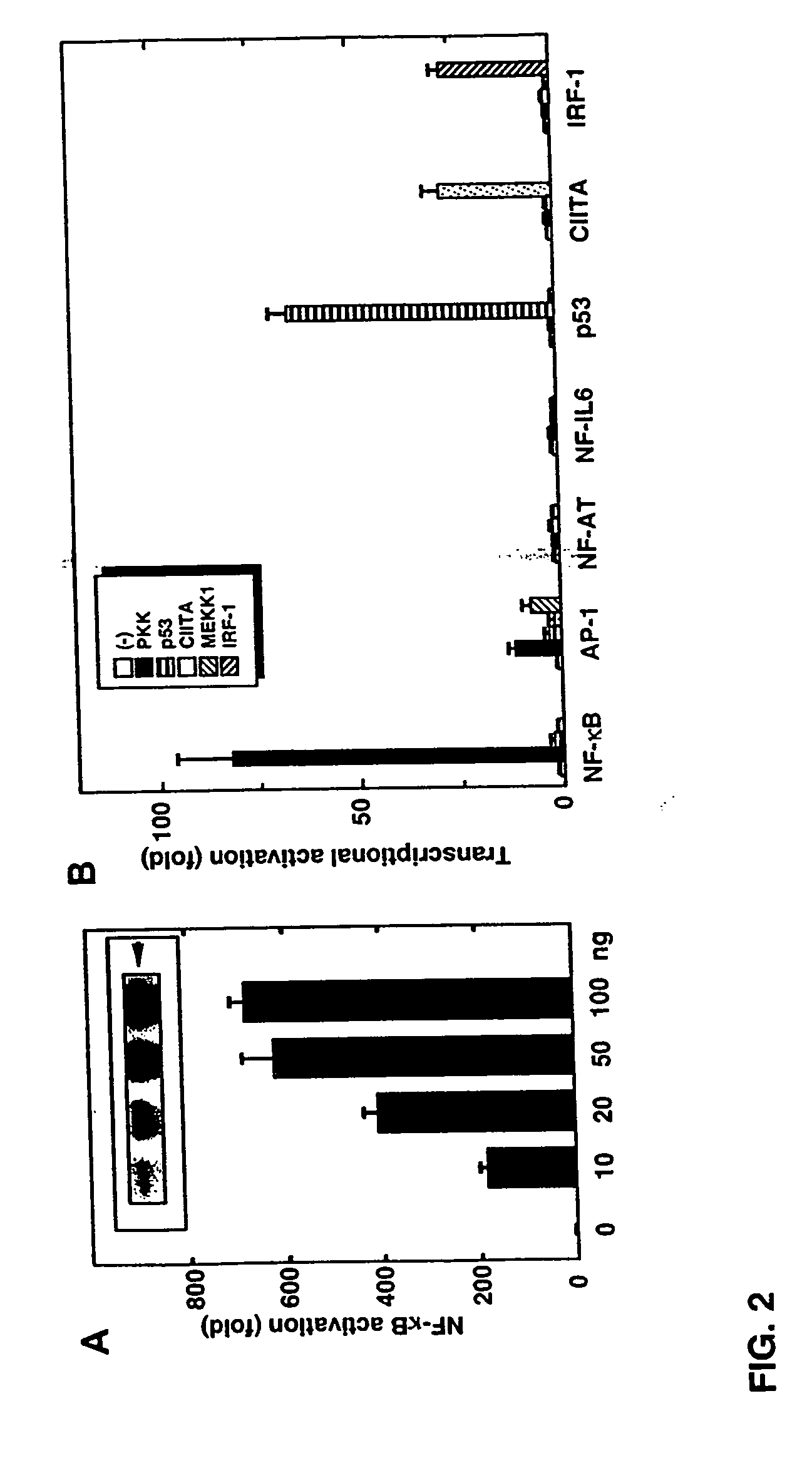RICK3 nucleic acids and proteins
a technology of rick3 and nucleic acids, applied in the direction of transferases, instruments, genetic material ingredients, etc., can solve the problems that the function of rick3 has not been addressed in the past, and achieve the effect of reducing binding and altering the level of kinase activity
- Summary
- Abstract
- Description
- Claims
- Application Information
AI Technical Summary
Benefits of technology
Problems solved by technology
Method used
Image
Examples
example 1
Methods
Cell Lines and Materials
[0320] Mouse embryonic fibroblasts lacking IKKα, IKKβ, both IKKα and IKKβ, Bcl10 and Rat-1 5R were described previously (Li et al., Genes Dev. 14:1729 [2000]; Ruland et al., Cell. 104:33 [2001]; Yamaoka et al., Cell 93, 1231 [1998]) and maintained in Dulbecco MEM containing 10% fetal calf serum and antibiotics. IL-1β and TNFα were purchased from Collaborative Biomedical Products. PMA, A23187 and other reagents were purchased from Sigma Chemicals. The partial nucleotide sequences of zebrafish cDNAs encoding peptides with homology to RICK3 were found in EST databases of Genrank using the TBLASTN program. The entire nucleotide sequence of EST clones GenBank BF158596 (zebrafish PKK) and BG737635 (zebrafish RICK) were determined by dideoxy sequencing.
Construction of Expression Plasmids
[0321] The open reading frame of mouse PKK was amplified by polymerase chain reaction (PCR) from random-primed mouse embryo E15 cDNA and cloned into pcDNA3-Flag, pcDNA3...
example 2
PKK is Highly Related to RICK
[0324] To identify novel RICK-like molecules, public protein and nucleotide databases were searched for homologous proteins using the entire RICK sequence (Inohara et al., J. Biol. Chem. 273:12296 [1998]). The search identified RIP (E values; 4×10−29 and 3×10−29 for human and mouse RIP, respectively) and its homologue RIP3 (E values; 1×10−31 and 5×10−30 for human and mouse RIP3, respectively) as molecules with significant homology to RICK (FIG. 1). In addition, the search identified PKK, a kinase of unknown function, as the most homologous protein to RICK in available databases (E=4×10−51 for mouse PKK and 4×10−50 for human PKK). The search also identified zebrafish orthologues of PKK and RICK. The domain structure of the fish PKK and RICK was identical to that of their mammalian orthologues (FIG. 1A). Zebrafish PKK was more homologous to human RICK (E=5×10−50) than human RICK to human RIP or RIP3 (FIG. 1B). PKK also exhibited significant similarity to...
example 3
PKK Activates NF-κB and AP-1
[0325] This example describes that the expression of PKK activates NF-κB. Transfection of the wild-type PKK cDNA into HEK293T cells induced activation of NF-κB in a dose-dependent manner, as measured with a reporter luciferase construct (FIG. 2A). The induction of NF-κB by PKK was specific in that transfection of the PKK cDNA did not induce transactivation of NF-AT, NF-IL6, p53, IRF-1 and class II MHC-dependent promoters (FIG. 2B). In control experiments, the transcriptional activity of the reporter constructs was stimulated by expression of proteins known to induce their activation (FIG. 2B). Expression of PKK induced significant activation of AP-1 (FIG. 2B) as did expression of MEKK1, a known activator of AP-1 (Xu et al., Proc. Natl. Acad. Sci. USA. 93:5291 [1996]).
PUM
| Property | Measurement | Unit |
|---|---|---|
| temperatures | aaaaa | aaaaa |
| diameter | aaaaa | aaaaa |
| nucleic acid sequence | aaaaa | aaaaa |
Abstract
Description
Claims
Application Information
 Login to View More
Login to View More - Generate Ideas
- Intellectual Property
- Life Sciences
- Materials
- Tech Scout
- Unparalleled Data Quality
- Higher Quality Content
- 60% Fewer Hallucinations
Browse by: Latest US Patents, China's latest patents, Technical Efficacy Thesaurus, Application Domain, Technology Topic, Popular Technical Reports.
© 2025 PatSnap. All rights reserved.Legal|Privacy policy|Modern Slavery Act Transparency Statement|Sitemap|About US| Contact US: help@patsnap.com



